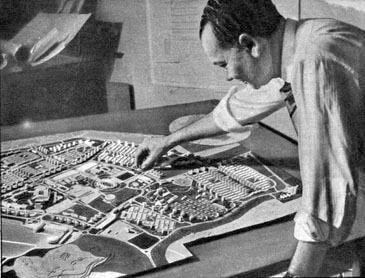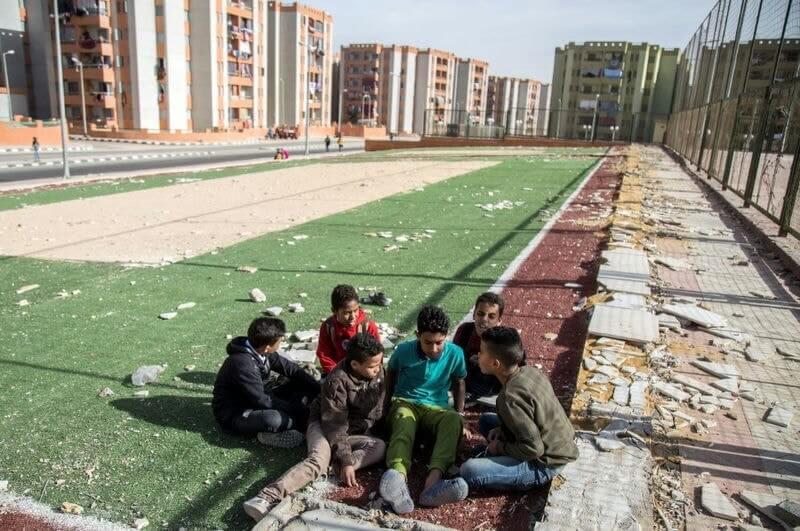Urban Renewal in Egypt
Urban renewal in Cairo, the capital of Egypt, over the past few decades has prioritized “slum clearance” with uneven results, and failed to ensure affordable housing for all of the city’s poor. Comparing urban renewal in Cairo to the West End suggests shared global challenges for urban redevelopment which remain with us today.
Cairo, the capital of Egypt and its largest city, has been undergoing urban renewal by the government of President (read dictator) Abdel Fattah El-Sisi, in office since 2014. El-Sisi’s administration seeks to rid Cairo of its informal settlements, which it calls “slums,” by 2030. 80% of the informal settlements are houses built without construction permits on privately-owned farm land, and the rest are squatters’ make-shift homes inside the city. 60% of Cairo’s population lives in the informal neighborhoods, which are mostly the poor and middle-class areas of greater Cairo. Egypt’s Informal Settlements Development Facility (ISDF), the agency in charge of “slum clearance,” evicts residents from their homes and relocates them to low-income housing areas outside Cairo, before ultimately demolishing each informal settlement one at a time. The ultimate goal of clearing out the “slums” is to replace them with luxury housing and commercial spaces, to attract wealthy residents and investors. But the immediate justification offered by El-Sisi’s government is that the informal neighborhoods are “unsafe areas,” or that the homes are unsafe for living in, because of their poor construction, lack of electricity or water, or vulnerability to rockslides. In November 2021, Egypt’s Urban Development Fund announced that 322 of 357 “unsafe areas,” classified as such by the government, have been developed.
But urban renewal in Egypt today is inextricably connected to decades of policy failures on the issue of affordable housing, which governments over time had failed to adequately support with well-funded, public infrastructure. Egypt’s modern style urban development dates back to the 10th century, when Cairo was built along the banks of the Nile River for the area’s fertile land. Multiple empires subsequently expanded Cairo’s boundaries along the Nile over centuries. After Egypt became an independent republic in 1953, poor, rural Egyptians moved to Cairo for better economic opportunities and living conditions, a trend which continued into the 1970s. As there had been lots of cheap, agricultural land just outside the city, farmers were incentivized to sell parcels of their land to migrants for them to build homes near Cairo. Egypt’s leaders in the twentieth century had failed to prioritize affordable housing development, according to architectural historian Mohamad Elshahed in a 2022 video for Vox. After President Gamal Abdel Nasser took office in 1953, his administration announced plans, in 1958, to create Nasr City as the new capital of Egypt. Nasr City was intended, however, to attract middle-class and wealthy residents with modern apartment blocks that did not have the poor in mind. Elshahed summed up the mindset of Nasr City’s planners as follows: “Nobody wants to build a shiny new capital and fill it with low-cost housing.” Nasser’s successor in 1970, Anwar Sadat, similarly planned new ‘desert cities’ outside Cairo, such as 10th of Ramadan City and Sadat City, yet these also consisted of expensive homes. With virtually no public transportation connecting these new cities to Cairo, workers and the poor were unable to live in Sadat’s new cities unless they owned cars.
Former “slum dwellers” have been relocated to neighborhoods built by El-Sisi’s government, such as el-Asmarat (which opened in 2016). Some have been displaced without assistance, such as one anonymous resident whose husband was at work while families could sign up for relocation to Asmarat, and thus missed the opportunity to register for an apartment. For those who were able to move into new apartments, hardships remain. Although el-Asmarat’s apartments are fully furnished and have a modest rent of 300-350 Egyptian pounds ($19-22), families used to owning their makeshift homes have struggled to pay rent on top of utility bills — 25% of Egyptians live on less than $1.65 a day. For Elshahed, another problem is stigmatization. He emphasizes that “from the point of view of the state, calling an area a “slum” facilitates its renewal.” Applying a critical lens to the purposes and effects of designating some areas as “slums,” Elshahed argues that poor residents are blamed for their conditions when the true blame lies with decades of policy failures. According to Reda Haggag, professor of urban planning at Cairo University, some people have returned to the slums or even built new ones, either because they cannot afford rent or simply do not want to leave their old homes. Residents of Asmarat are ambivalent about their new neighborhood. Some residents were concerned that the buildings are in a relatively more isolated part of the city, which disrupts daily routines. Others noted that the fully-furnished apartments left no room for families to bring their own furniture. Many residents said that they were grateful for the opportunity to live in a “nice district” with “civilized housing,” but still others felt displaced from the informal businesses they once ran out of their own homes (informal businesses are prohibited in the highly-supervised Asmarat settlement).
Construction underway for the business district of the New Administrative Capital (Photo by KHALED DESOUKI/AFP via Getty Images).
In 2015, El-Sisi’s government announced that it would begin construction of the New Administrative Capital, about 30 miles away from Cairo. The stated purposes are to relocate the government buildings and reduce overcrowding in Cairo, a city with a higher population density than New York and London. But from the standpoint of increasing affordable housing, development outside Cairo repeats the failures of previous decades. As Elshahed described the limitations of Sadat’s desert cities, with the New Administrative Capital in mind, “…the majority of the population that’s squeezed in the little green belt that’s now urbanized around the Nile are…’x’-d out of these developments. We’re looking at a condition that’s a result of…three to four decades in particular of misguided policy that looks to the outside of the city.” El-Sisi’s planning for the New Administrative Capital also has an underlying political motivation, to move the parliament and the presidential palace far away from the masses in Cairo who occupied the city’s Tahrir Square, and forced the previous president, Hosni Mubarak, to abdicate, during the Arab Spring uprisings in 2011. The new capital will have a public square, but the streets leading up to it will be much wider and therefore easier for the military to traverse and control. This motivation, to design cities with military suppression of protest in mind, was shared by Baron Haussmann in the nineteenth century, for his plans of urban renewal for Paris. Construction on the New Administrative Capital is slated for completion by 2030.
The Maspero Triangle neighborhood in Cairo, demolished in 2018 (Photo by KHALED DESOUKI / AFP via Getty Images).
The history of urban renewal in Egypt has been centrally shaped by trends both similar and different to urban renewal in the West End. The top-down, governmental definition of entire neighborhoods as “slums” conflicted with the interests of many residents, who face challenges after displacement and relocation. West Enders were promised state-supported relocation to affordable housing, yet that never transpired; in Egypt, the state did facilitate poor residents’ relocation but hurdles remain from residents’ perspectives. International comparisons between the histories of the West End and other neighborhoods reveal shared global challenges of urban redevelopment that remain with us today.
Article by Adam Tomasi, edited by Sebastian Belfanti
Source: Egypt Today; Vox; Reuters; Madamasr; Al-Monitor; JSTOR; ScienceDirect; Engineering News Record; Getty Images
Elshahed, M. (2015). Revolutionary Modernism? Architecture and the Politics of Transition in
Egypt, 1936-1967. Doctoral dissertation, Department of Middle Eastern and Islamic
Studies, New York University. ProQuest Dissertations Publishing.










